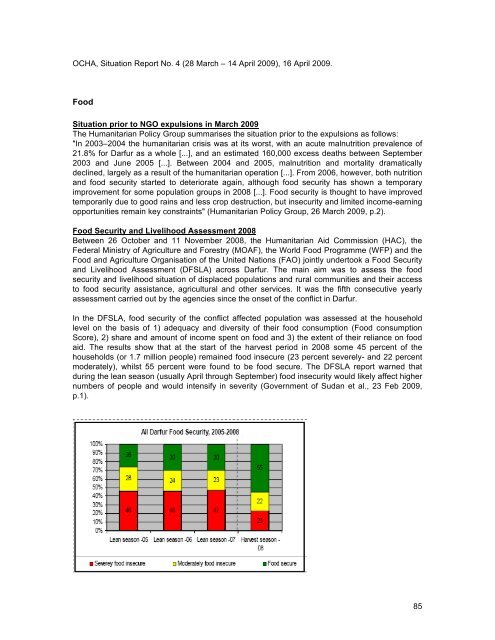SUDAN: Durable solutions elusive as southern IDPs return and ...
SUDAN: Durable solutions elusive as southern IDPs return and ...
SUDAN: Durable solutions elusive as southern IDPs return and ...
Create successful ePaper yourself
Turn your PDF publications into a flip-book with our unique Google optimized e-Paper software.
OCHA, Situation Report No. 4 (28 March – 14 April 2009), 16 April 2009.<br />
Food<br />
Situation prior to NGO expulsions in March 2009<br />
The Humanitarian Policy Group summarises the situation prior to the expulsions <strong>as</strong> follows:<br />
"In 2003–2004 the humanitarian crisis w<strong>as</strong> at its worst, with an acute malnutrition prevalence of<br />
21.8% for Darfur <strong>as</strong> a whole [...], <strong>and</strong> an estimated 160,000 excess deaths between September<br />
2003 <strong>and</strong> June 2005 [...]. Between 2004 <strong>and</strong> 2005, malnutrition <strong>and</strong> mortality dramatically<br />
declined, largely <strong>as</strong> a result of the humanitarian operation [...]. From 2006, however, both nutrition<br />
<strong>and</strong> food security started to deteriorate again, although food security h<strong>as</strong> shown a temporary<br />
improvement for some population groups in 2008 [...]. Food security is thought to have improved<br />
temporarily due to good rains <strong>and</strong> less crop destruction, but insecurity <strong>and</strong> limited income-earning<br />
opportunities remain key constraints" (Humanitarian Policy Group, 26 March 2009, p.2).<br />
Food Security <strong>and</strong> Livelihood Assessment 2008<br />
Between 26 October <strong>and</strong> 11 November 2008, the Humanitarian Aid Commission (HAC), the<br />
Federal Ministry of Agriculture <strong>and</strong> Forestry (MOAF), the World Food Programme (WFP) <strong>and</strong> the<br />
Food <strong>and</strong> Agriculture Organisation of the United Nations (FAO) jointly undertook a Food Security<br />
<strong>and</strong> Livelihood Assessment (DFSLA) across Darfur. The main aim w<strong>as</strong> to <strong>as</strong>sess the food<br />
security <strong>and</strong> livelihood situation of displaced populations <strong>and</strong> rural communities <strong>and</strong> their access<br />
to food security <strong>as</strong>sistance, agricultural <strong>and</strong> other services. It w<strong>as</strong> the fifth consecutive yearly<br />
<strong>as</strong>sessment carried out by the agencies since the onset of the conflict in Darfur.<br />
In the DFSLA, food security of the conflict affected population w<strong>as</strong> <strong>as</strong>sessed at the household<br />
level on the b<strong>as</strong>is of 1) adequacy <strong>and</strong> diversity of their food consumption (Food consumption<br />
Score), 2) share <strong>and</strong> amount of income spent on food <strong>and</strong> 3) the extent of their reliance on food<br />
aid. The results show that at the start of the harvest period in 2008 some 45 percent of the<br />
households (or 1.7 million people) remained food insecure (23 percent severely- <strong>and</strong> 22 percent<br />
moderately), whilst 55 percent were found to be food secure. The DFSLA report warned that<br />
during the lean se<strong>as</strong>on (usually April through September) food insecurity would likely affect higher<br />
numbers of people <strong>and</strong> would intensify in severity (Government of Sudan et al., 23 Feb 2009,<br />
p.1).<br />
85
















